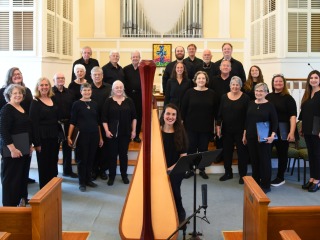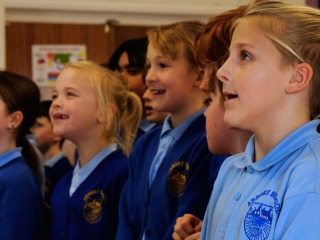MENU
10 Jan 2013
“THE PLOUGHMAN IN WIND-SWEPT FIELDS”
THE FOLK SINGERS FOUND BY DR JOHN CLAGUE
by Stephen Miller, Vienna
In 1913, Sophia Morrison wrote that “[t]he Ven. Archdeacon of Mann has handed over to the Manx Language Society the highly interesting collection of Folk Airs left by the late Dr Clague.” Dr John Clague had died in 1908, and his library and personal papers passed to the Rev. John Kewley. Amongst them were the four tune books that Morrison claimed (falsely) that the Archdeacon later passed over to the MLS. She was also very clear about where the tunes came from:
The songs were heard by the Doctor and taken down by him as he went his rounds among the people, who loved him, and whom he loved. To him the old folks dwelling in lonely places in the mountains or on the wild sea-coast unsealed their lips, and so he rescued from oblivion many songs sung by mother to babe, by fisherman at sea, by the ploughman in wind-swept fields, from generation to generation.
Here we see Morrison’s own perception of the Manx singing community as represented by Clague’s collecting—one that was elderly, living in remote spots and by so isolated from the rest of the Island, and where the transmission of folk song is passed on orally from generation to generation. Moreover, Clague found these singers as he went his rounds as a doctor in Rushen sheading as T.H. Kelly recounted:
One day the doctor was on his way to attend a “Confinement” when he was side-tracked and delayed on hearing a Manx fiddler playing a tune new to the doctor. Doctor Clague arrived at his patient’s home to find that a healthy baby had already been born. On explaining what had delayed him the worthy doctor received a stern lecture from the patient’s mother on the possible dire consequences of getting his “doctoring” mixed up with his hobby—“music.”
It is difficult to know the truth of this statement as it has a sentimental and somewhat cloying tone that makes one suspicious of its veracity, however elaborated it may be. This anecdote was later expanded on by Mona Douglas:
There are many stories of his doings, for he was reckoned a “character” and folk were not afraid to laugh at him on occasion, or to criticise. One story tells how he was summoned to deliver a baby, but got caught up on his way by a fiddler in Cregneish [sic] who played a tune Clague had never heard before. He stayed to take it down—and when he arrived at his destination it was to hear the cry of the new-born child as he went up the stairs.
Whereupon the mother told him sternly, “I know well enough where thou have been, doctor—fiddling with John Jemmy, just fiddling—I’m thinking I’d best send for Mistress Clague next time, not for thee at all!”
So far as we know, Clague never collected in Cregneash and it is likely that the name of the village is here to add an element of “Manx colour.”
The wider question, however, arises as to whether these perceptions are accurate or not—in simple terms, did Clague ever collect on his rounds, and if so, was it then from “the ploughman in wind-swept fields”? The answer lies in the four tune books now deposited in the Manx National Heritage Library containing the tunes collected by Clague. A good number, though not all, have the name of the person from whom the tune was collected. So, what then does this say about the singing community that Clague found?
The first thing that must be said is that Clague was a poor documenter of his collecting and certainly so in comparison with the Gill Brothers. The latter careful noted the name and often age of the singer found as well as where the recording session took place and wrote down the names of others attending the recording session. It has been possible for that pair to reconstruct their day-by-day activities in their collecting tours of 1895 and 1898. Returning to Clague, the names of informants do appear in the tune books and (very) occasionally dates.
The singers for whom we have names are 32 in total. Of these, one was dead by the time of the 1891 Census, namely Henry Clague of Ballanorris, Clague’s own father who died in 1883. Of the 31 then left, all but two of them can be found in the census: James Connor, said to be a stone cutter, was not enumerated and as regards James Clague, there are two such individuals so named, both living in Castletown, and no way to see which one was the singer for Clague. Turning to a breakdown by age, two were in their 80s, five in their 70s, eight in their 60s, ten in their 50s, two in their 40s, and two in their 30s. The eldest singer was Elizabeth Clague, aged 83, and Clague’s own mother and the youngest was John Cubbon at 32 years old. Evidently, Clague has no notion of an age criteria for his collecting unlike the Gill Brothers who sought out the oldest possible singers.
Looking at the singers themselves, what is clear is how many of them are from Clague’s own family as well as likely their friends: as seen, Clague’s own mother (aged 83) and father from Ballanorris, then Charles (55) and Anne Clague (56) from Ballaclague itself, Charles Clague (36), his cousin and coachman, living in Castletown. Margaret Clague (63), living in Colby as a retired farmer’s wife is likely either a grandmother or a great aunt to the Doctor. This leaves James Clague living in Castletown who may well turn out to be a relative. Moving away from the Clague family itself, we have living on Balladoole, George Moore (44), William Cannell (63), and Elizabeth Callister (76). And for Ballakeighan, across the road from Balladoole, was Isabella Kennaugh (77). These are well appointed quarterland farms: Ballanorris, Ballaclague, Balladoole, and Ballakeighan and all the singers here are enumerated as farmers or farmers’ wives.
Who then are the remainder of the singers? John Ratcliffe (58) living at the Howe at an agricultural labourer; John Wesley Cleator (54) was a baker and residing in Peel; Flaxney Stowell (76) in Castletown was a builder and contractor; Elinor Costain (66) at Colby was a domestic servant; John Moore (52) from Mill Croft at Colby was a farmer; John Cubbon (69) from Cross y Caley was a fisherman as was Charles Faragher (62) of Cross Four Ways; William Kaye (65) in Port St Mary was a general labourer; Thomas Kneen (40) from the same place was a joiner; Jane Stowell (74) from Castletown kept house as did Jane Taylor (74) of Port St Mary; Joseph Crellin (50) was a lead miner at Colby (presumably working in the Ballacorkish mine); Ellen Creer (83) was living on her own means in Castletown; John Cubbon (61) from the same town was a marble mason; Thomas Kermode (65) from Bradda was a mariner; Thomas Cain (57) from Douglas was a musician; another John Cubbon (32) and one again from Castletown was a painter and decorator; Richard Qualtrough (56) was a shoemaker and the Parish Clerk for Rushen and living on the glebe there; two more shoemakers were Simpson Clucas (54) fromCastletown and Edward Shimmin (76) at Ballasalla. Finally, James Connor, who cannot be found in the census, was noted by Clague as being a stone cutter. A closer look at these singers from the view point of residence shows the predominance of towns and villages from the south of the Island: Castletown, Port St Mary, Port Erin, Colby, and Ballasalla.
Returning to Morrison’s passage, we can now see that there are few candidates amongst Clague’s singers for the rôle of the “fisherman at sea” or as a “ploughman in wind-swept fields.” Instead, Clague’s collecting from his family and their friends shows the existence of a vernacular song tradition amongst the social élite of the southern farming community. His other singers show that the tradition is present in town as well as village and not just in the Manx countryside. The range and variety of activities carried on by singers (and not always completely captured by the census record) shows no correlation between occupation and singer. The age spread of singers shows the maintenance and active transmission of song in the Island. This was not of course what drove Clague in his collecting but thanks to that activity we can derive an insight into the singing community that, at least in the south of the Island, takes us away from a ruralist agenda about “the folk” and their songs. Finally, did Clague encounter these singers on his rounds? That remains an open question but this was a period in which a visit by the doctor was one you had to pay for and when any medicine prescribed had also to be purchased. It is more likely to be anecdotal rather than factual and another distortion of the pattern and method of Dr John Clague’s collecting.

Paid performance opportunity: ‘Cree’ Manx language and song project
30 Jun 2025
Read More...
This Fair Isle: Manx music arranged by Kevin Kelly
04 Jun 2025
Read More...
School celebrated in new Manx film
04 Jun 2025
Read More...
Contact, Links, Acknowledgements, Privacy
© Culture Vannin. Culture Vannin is the trading name for the Manx Heritage Foundation, registered charity 333 in the Isle of Man. Designed by 3 Legs Ltd.